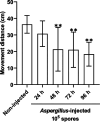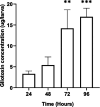Characterization of Aspergillus fumigatus secretome during sublethal infection of Galleria mellonella larvae
- PMID: 38836745
- PMCID: PMC11261830
- DOI: 10.1099/jmm.0.001844
Characterization of Aspergillus fumigatus secretome during sublethal infection of Galleria mellonella larvae
Abstract
Introduction. The fungal pathogen Aspergillus fumigatus can induce prolonged colonization of the lungs of susceptible patients, resulting in conditions such as allergic bronchopulmonary aspergillosis and chronic pulmonary aspergillosis.Hypothesis. Analysis of the A. fumigatus secretome released during sub-lethal infection of G. mellonella larvae may give an insight into products released during prolonged human colonisation.Methodology. Galleria mellonella larvae were infected with A. fumigatus, and the metabolism of host carbohydrate and proteins and production of fungal virulence factors were analysed. Label-free qualitative proteomic analysis was performed to identify fungal proteins in larvae at 96 hours post-infection and also to identify changes in the Galleria proteome as a result of infection.Results. Infected larvae demonstrated increasing concentrations of gliotoxin and siderophore and displayed reduced amounts of haemolymph carbohydrate and protein. Fungal proteins (399) were detected by qualitative proteomic analysis in cell-free haemolymph at 96 hours and could be categorized into seven groups, including virulence (n = 25), stress response (n = 34), DNA repair and replication (n = 39), translation (n = 22), metabolism (n = 42), released intracellular (n = 28) and cellular development and cell cycle (n = 53). Analysis of the Gallerial proteome at 96 hours post-infection revealed changes in the abundance of proteins associated with immune function, metabolism, cellular structure, insect development, transcription/translation and detoxification.Conclusion. Characterizing the impact of the fungal secretome on the host may provide an insight into how A. fumigatus damages tissue and suppresses the immune response during long-term pulmonary colonization.
Keywords: Aspergillus; Galleria mellonella; fungal–host interactions; gliotoxin; proteomics.
Conflict of interest statement
The authors declare that they have no conflicts of interests.
Figures








Similar articles
-
Correlation between gliotoxin production and virulence of Aspergillus fumigatus in Galleria mellonella.Mycopathologia. 2004 Jul;158(1):73-9. doi: 10.1023/b:myco.0000038434.55764.16. Mycopathologia. 2004. PMID: 15487324
-
Characterisation of the cellular and proteomic response of Galleria mellonella larvae to the development of invasive aspergillosis.BMC Microbiol. 2018 Jun 28;18(1):63. doi: 10.1186/s12866-018-1208-6. BMC Microbiol. 2018. PMID: 29954319 Free PMC article.
-
Galleria mellonella as a screening tool to study virulence factors of Aspergillus fumigatus.Virulence. 2021 Dec;12(1):818-834. doi: 10.1080/21505594.2021.1893945. Virulence. 2021. PMID: 33682618 Free PMC article. Review.
-
Gliotoxin, a Known Virulence Factor in the Major Human Pathogen Aspergillus fumigatus, Is Also Biosynthesized by Its Nonpathogenic Relative Aspergillus fischeri.mBio. 2020 Feb 11;11(1):e03361-19. doi: 10.1128/mBio.03361-19. mBio. 2020. PMID: 32047138 Free PMC article.
-
Galleria mellonella Larvae as a Model for Investigating Fungal-Host Interactions.Front Fungal Biol. 2022 Apr 26;3:893494. doi: 10.3389/ffunb.2022.893494. eCollection 2022. Front Fungal Biol. 2022. PMID: 37746216 Free PMC article. Review.
References
-
- Agarwal R, Muthu V, Sehgal IS, Dhooria S, Prasad KT, et al. Prevalence of Aspergillus sensitization and allergic bronchopulmonary Aspergillosis in adults with bronchial asthma: a systematic review of global data. J Allergy Clin Immunol Pract. 2023;11:1734–1751. doi: 10.1016/j.jaip.2023.04.009. - DOI - PubMed
MeSH terms
Substances
LinkOut - more resources
Full Text Sources

